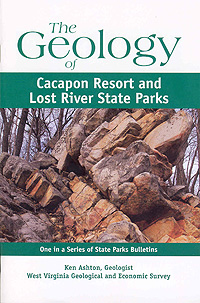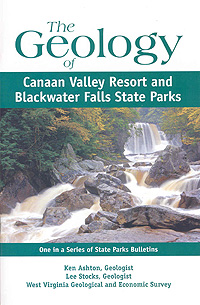 “The Geology of Cacapon Resort and Lost River State Parks” (State Park Bulletin SP-7) is a highly-illustrated geological tour through these two eastern panhandle state parks in
the Valley and Ridge physiographic province.* Cacapon Resort State Park is in Morgan County, and Lost River State Park is in Hardy County. The 36-page booklet describes the rocks
and geologic history that visitors will encounter in each park, and explains each park’s topography and prominent geological features. In addition to text written for the non-specialist,
the booklet is filled with explanatory illustrations and beautiful photographs. Fold-out colored geologic maps identify the rock units visible in each park area.
“The Geology of Cacapon Resort and Lost River State Parks” (State Park Bulletin SP-7) is a highly-illustrated geological tour through these two eastern panhandle state parks in
the Valley and Ridge physiographic province.* Cacapon Resort State Park is in Morgan County, and Lost River State Park is in Hardy County. The 36-page booklet describes the rocks
and geologic history that visitors will encounter in each park, and explains each park’s topography and prominent geological features. In addition to text written for the non-specialist,
the booklet is filled with explanatory illustrations and beautiful photographs. Fold-out colored geologic maps identify the rock units visible in each park area.
|
 “The Geology of Canaan Valley Resort and Blackwater Falls State Parks” (State Park Bulletin SP-6A) follows a similar format for these two eastern West Virginia state parks
in Tucker County, in the Allegheny Mountain Section of the Appalachian Plateau physiographic province. The highly-illustrated 32-page booklet describes the geology, rocks, and
landforms in these parks, including the geology responsible for the formation of the falls of the Blackwater River and the broad valley at Canaan. Fold-out colored geologic maps
identify the rock units visible in each of these parks areas.
“The Geology of Canaan Valley Resort and Blackwater Falls State Parks” (State Park Bulletin SP-6A) follows a similar format for these two eastern West Virginia state parks
in Tucker County, in the Allegheny Mountain Section of the Appalachian Plateau physiographic province. The highly-illustrated 32-page booklet describes the geology, rocks, and
landforms in these parks, including the geology responsible for the formation of the falls of the Blackwater River and the broad valley at Canaan. Fold-out colored geologic maps
identify the rock units visible in each of these parks areas.
|
 “The Geology of Cacapon Resort and Lost River State Parks” (State Park Bulletin SP-7) is a highly-illustrated geological tour through these two eastern panhandle state parks in
the Valley and Ridge physiographic province.* Cacapon Resort State Park is in Morgan County, and Lost River State Park is in Hardy County. The 36-page booklet describes the rocks
and geologic history that visitors will encounter in each park, and explains each park’s topography and prominent geological features. In addition to text written for the non-specialist,
the booklet is filled with explanatory illustrations and beautiful photographs. Fold-out colored geologic maps identify the rock units visible in each park area.
“The Geology of Cacapon Resort and Lost River State Parks” (State Park Bulletin SP-7) is a highly-illustrated geological tour through these two eastern panhandle state parks in
the Valley and Ridge physiographic province.* Cacapon Resort State Park is in Morgan County, and Lost River State Park is in Hardy County. The 36-page booklet describes the rocks
and geologic history that visitors will encounter in each park, and explains each park’s topography and prominent geological features. In addition to text written for the non-specialist,
the booklet is filled with explanatory illustrations and beautiful photographs. Fold-out colored geologic maps identify the rock units visible in each park area.
 “The Geology of Canaan Valley Resort and Blackwater Falls State Parks” (State Park Bulletin SP-6A) follows a similar format for these two eastern West Virginia state parks
in Tucker County, in the Allegheny Mountain Section of the Appalachian Plateau physiographic province. The highly-illustrated 32-page booklet describes the geology, rocks, and
landforms in these parks, including the geology responsible for the formation of the falls of the Blackwater River and the broad valley at Canaan. Fold-out colored geologic maps
identify the rock units visible in each of these parks areas.
“The Geology of Canaan Valley Resort and Blackwater Falls State Parks” (State Park Bulletin SP-6A) follows a similar format for these two eastern West Virginia state parks
in Tucker County, in the Allegheny Mountain Section of the Appalachian Plateau physiographic province. The highly-illustrated 32-page booklet describes the geology, rocks, and
landforms in these parks, including the geology responsible for the formation of the falls of the Blackwater River and the broad valley at Canaan. Fold-out colored geologic maps
identify the rock units visible in each of these parks areas.


 Page last revised: June 19, 2013
Page last revised: June 19, 2013